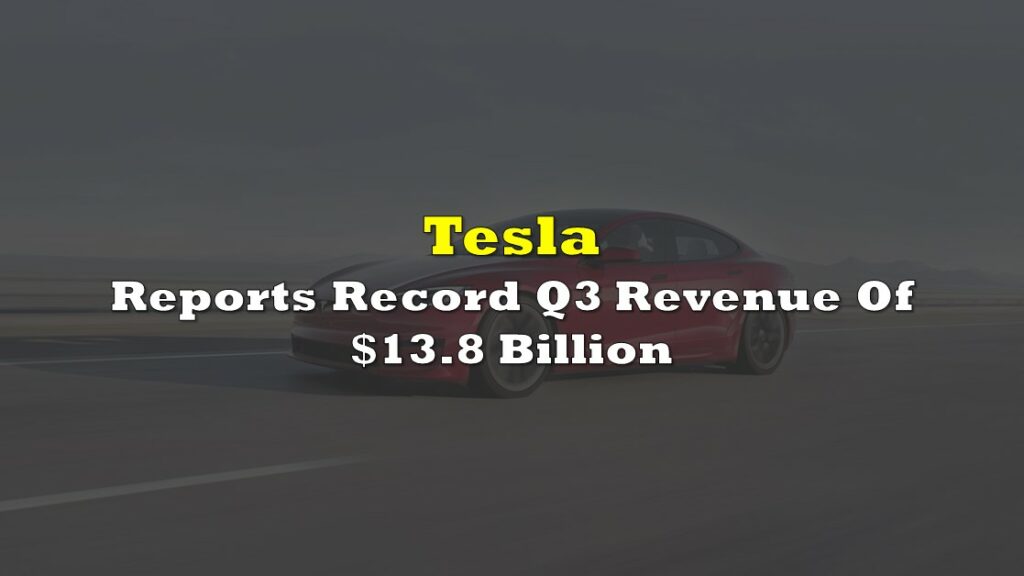Tesla Inc. (NASDAQ: TSLA) reported its financials for Q4 2024, with total revenue of $25.7 billion, reflecting a mere 2% year-over-year growth from $25.2 billion in Q4 2023 and a slight sequential increase from Q3 2024’s $25.18 billion.
For the full year 2024, Tesla reported total revenue of $97.69 billion, marking only a 1% year-over-year increase from the $96.77 billion reported in 2023.
What’s interesting is the automotive segment, Tesla’s core revenue driver, saw an 8% decline year-over-year in revenue to $19.8 billion from $21.56 billion in Q4 2023. This decline occurred amidst the backdrop of increased production capacity and the launch of new models. For 2024, automotive revenue totaled $77.07 billion, a 6% year-over-year decline from $82.42 billion in 2023.
BREAKING: Tesla, $TSLA, earnings:
— unusual_whales (@unusual_whales) January 29, 2025
– Revenue: $25.7 billion, est: $27.2 billion
– EPS: $0.73, est: $0.77
Automotive regulatory credit revenue also decreased to $692 million, a 20% drop from Q4 2023’s $867 million.
Gross margin for Q4 2024 was 16.3%, significantly lower than the 17.6% reported in Q4 2023 and 19.8% in Q3 2024. This contraction can be attributed to sustained price cuts across its vehicle lineup, higher production costs, and lower fixed-cost absorption due to reduced production volume.
Operating income stood at $1.6 billion in Q4 2024, down 23% from $2.06 billion in Q4 2023 and a steep drop from the $2.7 billion recorded in Q3 2024. Tesla’s operating margin has now slipped to 6.2%, a decline of 200 basis points quarter-over-quarter and 204 basis points year-over-year.
For the year, operating income was $7.07 billion, marking a 20% drop from $8.89 billion in 2023. Operating margin for the year also deteriorated to 7.2%, down 194 basis points from 9.2% in 2023
$TSLA
— Q-Cap (@qcapital2020) January 29, 2025
7% operating margins but it's not a car company
OK MR MARKET LOL pic.twitter.com/GqkIcjyS36
Net income for 2024 was $7.09 billion, a steep 53% decline from $14.99 billion in 2023. This decline was driven by a combination of lower automotive gross margins, rising operating expenses, and reduced regulatory credit revenue. On a non-GAAP basis, net income was $8.42 billion, still down 23% year-over-year from $10.88 billion in 2023.
For Q4, net income came in at $2.32 billion, also a decline from last year’s $7.93 billion but a marginal increase from last quarter’s $2.17 billion.
Earnings per share for the quarter ended at $0.73, falling short of the consensus estimate of $0.77. This marks a mere 3% year-over-year growth from Q4 2023’s non-GAAP diluted EPS of $0.71, a worrying sign for a company trading at a 189x forward P/E multiple. This ratio remains vastly higher than its tech peers, including Apple at 34x, Microsoft at 36x, and Amazon at 49x.
If Tesla’s core automotive business continues to struggle with margin compression and slowing revenue growth, its stock price could be exposed to a sharp correction.
The decline in EPS is also apparent for the annual figure, with 2024 reporting a GAAP diluted EPS at $2.04, a 53% decrease from $4.30 in 2023. Non-GAAP diluted EPS for the year came in at $2.42, down 22% year-over-year from $3.12.
“Investors may not get excited”… meanwhile $TSLA just went ex-growth in ‘24, yet is trading at 189x 2025E EPS. This means the mkt expects $TSLA to pay it, as a dividend, 100% of its 2025E net income for the next 189yrs. If TSLA is not growing, which it isn’t, this is insanity https://t.co/gXStwe31a9 pic.twitter.com/1d4IdcaYjg
— Gordon Johnson (@GordonJohnson19) January 29, 2025
A critical detail in Tesla’s net income figure is the inclusion of a $600 million mark-to-market gain on digital assets, primarily Bitcoin. This gain, despite being non-operational, accounted for approximately 17 cents of Tesla’s EPS.
On adjusted basis, sans the non-recurring gain, EPS would be closer to $0.53, a significant earnings miss.
1/3 ~$600mn, or 17c of the 73c $TSLA reported in Q4 came from the marking up the value of their #Bitcoin (NOT selling it, but, rather, marking it up). And, that ~$600mn carried with it 100% net margins. So, excluding an accounting parlor trick, or looking at $TSLA's core… pic.twitter.com/eB5YYjpTUW
— Gordon Johnson (@GordonJohnson19) January 29, 2025
Free cash flow, which Tesla bulls have long pointed to as a strength, came in at $2.0 billion for the quarter, nearly flat compared to Q4 2023 but significantly lower than Q3 2024’s $2.74 billion. Full year, free cash flow totaled $3.58 billion, representing an 18% decline from $4.36 billion in 2023.
Capital expenditures increased to $2.78 billion, a 21% year-over-year jump, reflecting Tesla’s continued investments in AI, FSD, energy storage expansion, and vehicle production facilities. This figure also surged to $11.34 billion in 2024, up 27% year-over-year.
Tesla’s balance sheet remains strong, with $36.6 billion in cash and cash equivalents, a $7.5 billion year-over-year increase and a $2.9 billion increase sequentially.
Inventory levels remain elevated, with days of supply increasing to 12 from 10 a year ago, suggesting that demand remains a challenge despite aggressive discounting and financing incentives. The company’s deliveries totaled 495,570 units, reflecting a mere 2% year-over-year growth. Model 3 and Model Y deliveries accounted for 471,930 units, a marginal increase from 461,538 in Q4 2023. Meanwhile, deliveries of other models, including the Cybertruck, reached 23,640 units, a modest 3% increase year-over-year.
Tesla claims FSD (supervised) has accumulated over three billion miles driven, but until it reaches full autonomy with Tesla assuming liability, there is an air of skepticism of its commercial viability.
Information for this story was found via the sources and companies mentioned. The author has no securities or affiliations related to the organizations discussed. Not a recommendation to buy or sell. Always do additional research and consult a professional before purchasing a security. The author holds no licenses.









